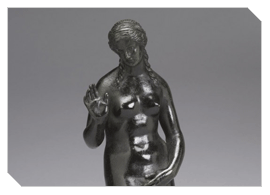

Have you ever walked through a museum and noticed a sculpture that you just wanted to reach out and touch? Sure, but of course you didn’t because the first rule of museums is that you can look - but you don’t touch. But your desire to reach for certain pieces may have been exactly the reaction that the sculptor intended for you to feel.
Back in the 1500’s, for example, artisans started creating various new devices specifically for holding in the hand. Large heavy hourglasses common during this time, for instance, became the small pocket watches - which easily fit in the palm. Similarly, small sculptures, sized to be held and touched, also became very popular.
According to experts at The Walters Museum in Baltimore, Maryland, sculptors may have designed these works to appeal to our sense of touch by incorporating pleasing shapes and textures specifically sized just for our hands.
But when sculptures are meant to be touched and held, how does a modern museum display these pieces while still protecting them?
The curators at The Walters wondered if there were ways to leverage new 3D technologies to create an exhibit that would allow and even encourage touching the sculptures. So they called Direct Dimensions.
With extensive art and museum experience, including customers such as The National Gallery, MoMA, The Getty Museum, and Jeff Koons, our toolbox of 3D technologies was a natural fit for this project. A planning meeting was held to discuss the overall goals for the project and various methods for utilizing 3D technologies to realize the exhibit. It was determined that three types of 3D technologies would be used: 3D scanning, 3D modeling, and 3D printing.
In other words, the original sculptures would be laser scanned, digitally modeled, and then re-created using 3D printing. These reproductions could surely be touched!
DDI technicians went to The Walters Art Museum in downtown Baltimore and spent a day scanning several original small bronze sculptures using two types of 3D lasers: a FARO ScanArm and a Konica Minolta Range 7. This equipment captured the exact shape and contours of the intricate pieces to an accuracy of about a tenth of a millimeter.
Then, back in DDI’s office over the next few days, the modeling team used Innovmetric’s PolyWorks Modeler software and other tools to post-process the raw laser data into high quality “watertight” 3D digital replicas.
These final 3D models, stored in a mesh format known as STL, were then used to create physical copies of the original bronzes through a process popularly known as additive manufacturing, or more commonly 3D printing. In addition to the physical replicas, this digital data was also used to visualize the sculptures in 3D on the web and to make digital renderings of the pieces.
The sculpture replications (and originals) were included in The Walters exhibit “Touch and the Enjoyment of Sculpture,” curated in conjunction with the Mind/Brain Institute of Johns Hopkins University.
In the exhibit attendees were invited to handle the replicas to their hearts’ content. In addition to handling the artwork they were also invited to give their reactions to the tactile sensations in a scientific survey created by the Mind/Brain Institute. The surveys helped scientists at Hopkins in their study of touch and corresponding neural activity.
The sculpture scanning project was a huge success, allowing The Walters Museum of Art to display their bronze sculptures in a new and interesting way, exhibit attendees the chance to touch and hold exact replicas of these highly tactile works of art, and the Mind/Brain institute of Johns Hopkins University was able to gather valuable data – all thanks to the use of 3D technologies.
See also:
Website for Walters exhibit:
http://thewalters.org/news/releases/pressdetail.aspx?e_id=333
Venus sculpture online in 3D at SketchFab:
http://skfb.ly/jig2da
A SunPapers article:
http://articles.baltimoresun.com/2012-01-13/entertainment/bs-ae-walters-touch-20120113_1_walters-exhibit-joaneath-spicer-touch